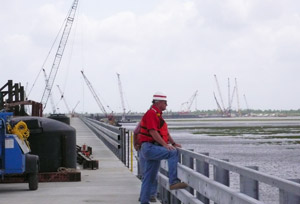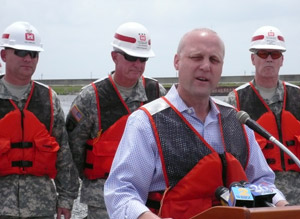With the rapid advance of work on a surge barrier on New Orleans� eastern flank, the city has substantially more protection against storm surge than it had just a year ago.


Public officials drove home that point at a presentation in the city May 13.
Karen Durham-Aguilera, director of the U.S. Army Corps of Engineers’ Task Force Hope, which oversees the Corps’ $14.6 billion mission to bring southeast Louisiana to 100-year levels of protection by June 2011, said the improved protection on the eastern flank comes from the $1.3-billion Lake Borgne Inner Harbor Navigation Canal storm surge barrier.
It is now is largely in place, months ahead of schedule.
Durham-Aguilera says even without its navigation channel gates in place, the barrier will significantly impede storm surge from entering the city on its most vulnerable side.
The surge barrier was called “the big daddy of them all” by Lt. Gen. Robert L. Van Antwerp, Jr., chief of engineers and commanding general of the Corps. He and Mayor Mitch Landrieu of New Orleans heralded the rapid progress of the wall, which represents the bulk of the project.
“When you stand on it, you can appreciate the enormity of it,” Van Antwerp said.
Landrieu praised the Corps for being “on task and on time” and for building levees “better than before.”
About the surge barrier, he added, “When you see it, you’ll be impressed with the level of protection it gives us. But it reminds us, in a very sobering way...the continued threat the people of Louisiana continue to exist under.”
Since it blocks waterways well east of downtown, most of the people the barrier protects likely will never lay eyes on it, and many don’t understand its role in blocking surges from Lake Borgne and the Gulf of Mexico. But the barrier is the key component of the 350 miles of levees, pump stations, gates and walls being linked to provide a system of protection that never before existed.
“People way over there might ask if it is helping because it’s way over here,” Van Antwerp said, gesturing toward St. Bernard Parish in the distance. “It is helping.”
The barrier is the largest design-build civil works project in the history of the Corps and the largest of its kind in the world, say Corps officials. It includes a wall 24 ft to 26 ft above the water line, three navigation gates and on-land tie-ins to concrete T-walls.
Prime contractor Shaw Environmental & Infrastructure expects to deliver 90% of the project by June 1, the start of hurricane season. Work on navigation gates will continue through June 1, 2011.
Harold Daigle, project management engineer supervisor in the Governor's Office of Coastal Protection and Restoration, called the project “unbelievable and phenomenal,” not only from an engineering standpoint, but from a coordination and construction standpoint.
“It will change the way we view civil works construction,” he said.
Charlie Hess, Shaw’s project manager, said the “art” of marrying constructability with engineering and design is a hallmark of the project. He added, however, that although Shaw is proud of the progress since the first pile was driven May 9, 2009, it is important to “keep our eye on the prize.”
On July 4, the Corps plans to present the completed wall, “nearly two months ahead of schedule” to the people of St. Bernard and Orleans parishes, said Col. Robert Sinkler, commander of the Corps’ Hurricane Protection Office in New Orleans.
New Orleans still can’t rest easily when it comes to hurricanes because the massive structure doesn’t translate into independence from flooding.
Sinkler noted that the Corps consistently maintains that “risk cannot be eliminated; everyone shares responsibility for buying down risk through insurance, zoning and building codes, coastal protection and restoration, and complying with mandatory evacuations.”
Tim Doody, chairman of the South Louisiana Flood Protection Authority-East, also reminded that “water has no boundaries,” so a regional approach and constant vigilance are required to maintain protection. “The Corps has done a good job, but we want more.”

Post a comment to this article
Report Abusive Comment